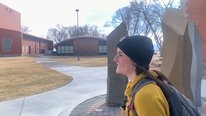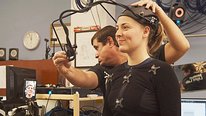- Meeko Oishi
- http://www.unm.edu/~oishi
- Associate Professor
- Cognitive Autonomy for Human Cyber-Physical Systems
- https://autonomy.unm.edu/
- University of New Mexico
- Tahira Reid Smith
- Associate Professor
- Cognitive Autonomy for Human Cyber-Physical Systems
- https://autonomy.unm.edu/
- Purdue University
Cognitive Autonomy for Human Cyber-Physical Systems
Human interaction with autonomous cyber-physical systems is becoming ubiquitous in consumer products, transportation systems, manufacturing, and many other domains. This NSF Cyber-Physical Systems program Frontier award, “Cognitive Autonomy for Human CPS: Turning Novices into Experts,” seeks constructive methods to answer the question: How can we design cyber-physical systems to be responsive and personalized, yet also provide high-confidence assurances of reliability? Cyber-physical systems that adapt to the human, and account for the human's ongoing adaptation to the system, could have enormous impact in everyday life as well as in specialized domains (biomedical devices and systems, transportation systems, manufacturing, military applications), by significantly reducing training time, increasing the breadth of the human's experiences with the system prior to operation in a safety-critical environment, improving safety, and improving both human and system performance. This program features a significant outreach component, the Summer Intensive Research Institute (SIRI), to encourage students to consider careers in cyber-physical systems, through summer undergraduate research. Undergraduate students at the University of New Mexico, a Hispanic serving institution, will participate in an 8-week research session, in pairs, at Purdue University, with faculty conducting research in cyber-physical systems. SIRI provides a coordinated, culturally relevant program of research and professional development, in a manner that bridges students’ cultural contexts, and exploits opportunities for mentoring and for visible representation of underrepresented minority scientists and engineers. Through SIRI, we seek to examine how language and culture intersect, to help participating students develop identities as experts, as well as the conditions that support this development.
Cognitive Autonomy for Human Cyber-Physical Systems
Human interaction with autonomous cyber-physical systems is becoming ubiquitous in consumer products, transportation systems, manufacturing, and many other domains. This NSF Cyber-Physical Systems program Frontier award, “Cognitive Autonomy for Human CPS: Turning Novices into Experts,” seeks constructive methods to answer the question: How can we design cyber-physical systems to be responsive and personalized, yet also provide high-confidence assurances of reliability? Cyber-physical systems that adapt to the human, and account for the human's ongoing adaptation to the system, could have enormous impact in everyday life as well as in specialized domains (biomedical devices and systems, transportation systems, manufacturing, military applications), by significantly reducing training time, increasing the breadth of the human's experiences with the system prior to operation in a safety-critical environment, improving safety, and improving both human and system performance. This program features a significant outreach component, the Summer Intensive Research Institute (SIRI), to encourage students to consider careers in cyber-physical systems, through summer undergraduate research. Undergraduate students at the University of New Mexico, a Hispanic serving institution, will participate in an 8-week research session, in pairs, at Purdue University, with faculty conducting research in cyber-physical systems. SIRI provides a coordinated, culturally relevant program of research and professional development, in a manner that bridges students’ cultural contexts, and exploits opportunities for mentoring and for visible representation of underrepresented minority scientists and engineers. Through SIRI, we seek to examine how language and culture intersect, to help participating students develop identities as experts, as well as the conditions that support this development.
-
 Socioscientific Argumentation Intervention
Socioscientific Argumentation Intervention
Sarah Krejci
-
 Coalition for Computational Science Learning: Next Steps
Coalition for Computational Science Learning: Next Steps
Matthew Ikle
-
 Signing Avatars & Immersive Learning
Signing Avatars & Immersive Learning
Lorna Quandt
-
 Preparing Technicians for the Future of Work
Preparing Technicians for the Future of Work
Ann-Claire Anderson
-
 A Medical Mystery: Middle School Body Systems for the NGSS
A Medical Mystery: Middle School Body Systems for the NGSS
Susan Kowalski
-
 Feeling Connected to Others Can Improve STEM Engagement
Feeling Connected to Others Can Improve STEM Engagement
Marley Jarvis
2001 Views
Continue the discussion of this presentation on the Multiplex. Go to Multiplex
2001 Views
presentation
has been viewed
Related videos you might be interested in...
-
 Socioscientific Argumentation Intervention
Socioscientific Argumentation Intervention
Sarah Krejci
-
 Coalition for Computational Science Learning: Next Steps
Coalition for Computational Science Learning: Next Steps
Matthew Ikle
-
 Signing Avatars & Immersive Learning
Signing Avatars & Immersive Learning
Lorna Quandt
-
 Preparing Technicians for the Future of Work
Preparing Technicians for the Future of Work
Ann-Claire Anderson
-
 A Medical Mystery: Middle School Body Systems for the NGSS
A Medical Mystery: Middle School Body Systems for the NGSS
Susan Kowalski
-
 Feeling Connected to Others Can Improve STEM Engagement
Feeling Connected to Others Can Improve STEM Engagement
Marley Jarvis


Meeko Oishi
Associate Professor
Thank you for visiting our video on our NSF Cyber-Physical Systems (CPS) Frontier project, “Cognitive Autonomy for Human CPS.” This project is in its first of five years. The focus of our video is on our primary research objectives, and on our outreach program, a summer intensive research internship for undergraduate students. This program incorporates culturally responsive pedagogy, to create an inclusive environment for underrepresented students and give them tools to integrate their backgrounds within the context of CPS. We welcome feedback and comments on all aspects of our project.
Devon Russell
Very interesting project! Have you looked into incorporating this into the agriculture industry?
Meeko Oishi
Associate Professor
Hi Devon,
Thanks for the feedback. Our industrial partners are focused primarily on aerospace, robotics, and defense applications, but the techniques we are developing are general, and may very well be applicable to other domains, such as agriculture. Interesting idea!
regards
Meeko
Stephen Alkins
Diversity, Equity, and Inclusion Officer
Definitely an intriguing project!!! I would definitely like to learn more:
Thank you so much for sharing!!!
Meeko Oishi
Associate Professor
Hi Stephen,
Thanks for the comments. We are doing a few things to create a culturally responsive pedagogy: we are creating a professional development curriculum that will be delivered concurrently with the research experience, having students reflect at several points on how their backgrounds contribute to their experience with CPS, and providing weekly opportunities for students to interact with visibly underrepresented researchers and scientists in CPS through a virtual seminar series. One of our team members will analyze the language that students employ in discussion boards and diary cams, to better understand how students contextualize their research experience. We're also conducting formal evaluations each year, and plan to use this feedback to iterate on our program design and implementation.
This was to be our first summer with the students, but unfortunately, we had to cancel due to coronavirus. Our research projects were almost all hardware- and human-subject based, in ways that were not amenable to even very creative virtual versions. So we will launch our summer program in 2021, and look forward to seeing how it goes!
Thanks,
Meeko
Stephen Alkins Ph.D.
Wendy Smith
Research Professor
Thanks for sharing your video. I wonder about how you plan to measure identity development of your participants?
Meeko Oishi
Associate Professor
Hi Wendy, thanks for your feedback. My collaborator, Prof. Tryphenia Peele-Eady, has provided the following info:
We will use self-reporting, through a study of language, to examine the ways participants talk about themselves and each other in relation to the experience.
The self-reporting will occur through use of a diary cam, as well as through moderated discussions amongst the students.
Feng Liu
Senior Researcher
Thanks for sharing this interesting project! Culturally responsive approach is an important instructional strategy especially for underrepresented students. Providing an authentic, safe, and culturally enriched learning environment can definitely help increase the chance of academic success for those students. I am curious about the type of languages as well as cultures being integrated in the system to accommodate the needs of those underrepresented students with different backgrounds.
Stephen Alkins Ph.D.
Meeko Oishi
Associate Professor
Hi Feng, thanks for your comments. UNM, the lead institution for the project, is a Hispanic Serving Institution, and we hope to recruit many students locally from New Mexico. However, we are also recruiting more broadly through national networks that UNM's Equity and Inclusion Office is involved with. This year, we had about 60% of our applicants from New Mexico, and 40% from other places in the US.
Stephen Alkins Ph.D.
Feng Liu
Senior Researcher
Thanks for sharing these information, Meeko. It makes sense for the institution to recruit heavily from the local state. What I hope to see is that for the 40% of applicants recruited from other states have more diversity in different ways (e.g., gender, race/ethnicity).